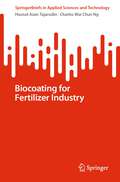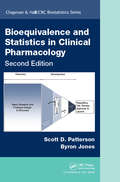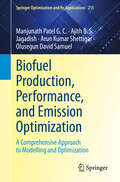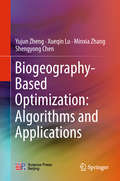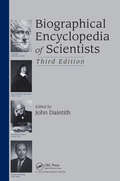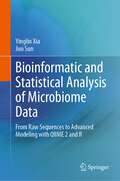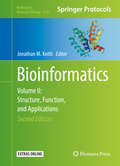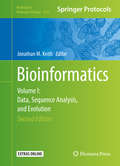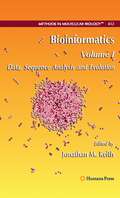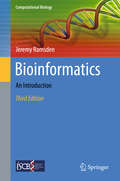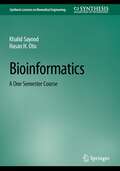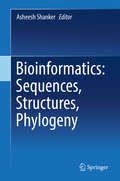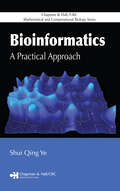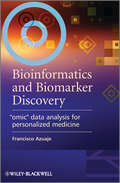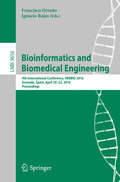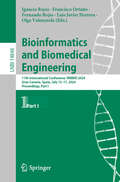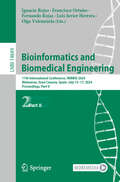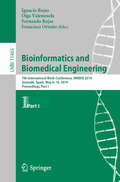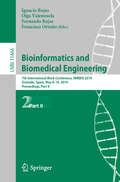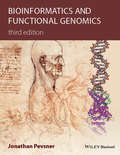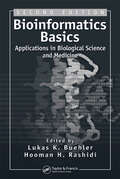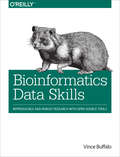- Table View
- List View
Biochemistry of Women Methods: For Clinical Investigation
by A.S. CurryThis book is written by experts who, using the latest techniques, describe laboratory investigations into women from conception to the grave. We asked the authors tp pay particular attention to the interpretation of laboratory results so we hope the book will be of interest to clinicians as well as to medical scientists.
Biocoating for Fertilizer Industry (SpringerBriefs in Applied Sciences and Technology)
by Husnul Azan Tajarudin Charles Wai NgThis book presents the advancement of coating materials technology especially in agriculture, particularly for fertilizers. Fertilizers are a critical component in meeting rising demands and ensuring global food security. A new generation of fertilizers made by coating granules with biopolymers address these issues. Coating in agriculture is an important area in research for a more sustainable future. Many examples and instances from existing research and related research gaps are discussed. It includes applications of composites as fertilizer’s coating, advantages and disadvantages of fertilizer coating from composites, applications of bacteria in composite, applications of bacteria in fertilizer industry as well as the common techniques of coating fertilizers with drying process.
Bioequivalence and Statistics in Clinical Pharmacology (Chapman & Hall/CRC Biostatistics Series)
by Scott D. Patterson Byron JonesMaintaining a practical perspective, Bioequivalence and Statistics in Clinical Pharmacology, Second Edition explores statistics used in day-to-day clinical pharmacology work. The book is a starting point for those involved in such research and covers the methods needed to design, analyze, and interpret bioequivalence trials; explores when, how, and why these studies are performed as part of drug development; and demonstrates the methods using real world examples. Drawing on knowledge gained directly from working in the pharmaceutical industry, the authors set the stage by describing the general role of statistics. Once the foundation of clinical pharmacology drug development, regulatory applications, and the design and analysis of bioequivalence trials are established, including recent regulatory changes in design and analysis and in particular sample-size adaptation, they move on to related topics in clinical pharmacology involving the use of cross-over designs. These include, but are not limited to, safety studies in Phase I, dose-response trials, drug interaction trials, food-effect and combination trials, QTc and other pharmacodynamic equivalence trials, proof-of-concept trials, dose-proportionality trials, and vaccines trials. This second edition addresses several recent developments in the field, including new chapters on adaptive bioequivalence studies, scaled average bioequivalence testing, and vaccine trials. Purposefully designed to be instantly applicable, Bioequivalence and Statistics in Clinical Pharmacology, Second Edition provides examples of SAS and R code so that the analyses described can be immediately implemented. The authors have made extensive use of the proc mixed procedures available in SAS.
Biofuel Production, Performance, and Emission Optimization: A Comprehensive Approach to Modelling and Optimization (Springer Optimization and Its Applications #215)
by Manjunath Patel G. C. Ajith B. S. Jagadish Arun Kumar Shettigar Olusegun David SamuelThis book explores the urgent quest for sustainable energy solutions by examining potential renewable energy sources that meet global demands. As fossil fuels deplete at an alarming rate, this book addresses the critical challenges in selecting sustainable feedstocks and optimizing processes for industrial-scale biodiesel production. With a focus on Garcinia-gummi-gutta seeds as a promising feedstock, the book provides a detailed analysis of oil extraction, biofuel conversion, and the practical application of biodiesel in diesel engines. Key concepts explored include selecting and optimizing transesterification variables, engine performance, and emission characteristics. The authors employ cutting-edge tools such as statistical design of experiments and artificial intelligence to offer insights into biodiesel production's physics, kinetics, and mechanics. Readers will discover experimental results, intelligent modeling techniques, and optimization strategies that enhance biodiesel yield and engine efficiency while minimizing emissions. This resource is designed for engineers and researchers in renewable energy and biofuel production. It offers a systematic framework from feedstock selection to engine optimization, making it invaluable for those seeking to advance their knowledge in sustainable energy solutions. Whether you're a novice or a seasoned professional, this book provides the tools and insights needed to drive innovation in biodiesel production at an industrial scale.
Biogeography-Based Optimization: Algorithms and Applications
by Shengyong Chen Minxia Zhang Xueqin Lu Yujun ZhengThis book introduces readers to the background, general framework, main operators, and other basic characteristics of biogeography-based optimization (BBO), which is an emerging branch of bio-inspired computation. In particular, the book presents the authors’ recent work on improved variants of BBO, hybridization of BBO with other algorithms, and the application of BBO to a variety of domains including transportation, image processing, and neural network learning. The content will help to advance research into and application of not only BBO but also the whole field of bio-inspired computation. The algorithms and applications are organized in a step-by-step manner and clearly described with the help of pseudo-codes and flowcharts. The readers will learn not only the basic concepts of BBO but also how to apply and adapt the algorithms to the engineering optimization problems they actually encounter.
Biographical Encyclopedia of Scientists
by John DaintithNew Edition of a Highly Regarded Reference As the first fully updated version in almost a decade, this comprehensive compendium brings together 2400 scientists who have made important contributions to the wide world of science. Rather than a Who's-Who style laundry list, this user-friendly resource provides essential biographical information and fo
Bioinformatic and Statistical Analysis of Microbiome Data: From Raw Sequences to Advanced Modeling with QIIME 2 and R
by Jun Sun Yinglin XiaThis unique book addresses the bioinformatic and statistical modelling and also the analysis of microbiome data using cutting-edge QIIME 2 and R software. It covers core analysis topics in both bioinformatics and statistics, which provides a complete workflow for microbiome data analysis: from raw sequencing reads to community analysis and statistical hypothesis testing. It includes real-world data from the authors’ research and from the public domain, and discusses the implementation of QIIME 2 and R for data analysis step-by-step. The data as well as QIIME 2 and R computer programs are publicly available, allowing readers to replicate the model development and data analysis presented in each chapter so that these new methods can be readily applied in their own research. Bioinformatic and Statistical Analysis of Microbiome Data is an ideal book for advanced graduate students and researchers in the clinical, biomedical, agricultural, and environmental fields, as well as those studying bioinformatics, statistics, and big data analysis.
Bioinformatics: Volume II: Structure, Function, and Applications (Methods in Molecular Biology #1526)
by Jonathan M. KeithIn Bioinformatics, leading researchers provide a selection of the most useful and widely applicable methods, able to be applied as is, or with minor variations, to many specific problems. Volume II: Structure, Function and Applications contains methods pertinent to the prediction of protein and RNA structures and the analysis and classification of structures, methods for inferring the function of previously identified genomic elements, chiefly protein-coding genes, medical applications in diagnostics and drug discovery, and "meta-methods" for developers of bioinformatics algorithms. Over 80 authors from around the globe have contributed to the two volumes.
Bioinformatics: Volume I: Data, Sequence Analysis, and Evolution (Methods in Molecular Biology #1525)
by Jonathan M. KeithIn Bioinformatics, leading researchers provide a selection of the most useful and widely applicable methods, able to be applied as is, or with minor variations, to many specific problems. Volume II: Structure, Function and Applications contains methods pertinent to the prediction of protein and RNA structures and the analysis and classification of structures, methods for inferring the function of previously identified genomic elements, chiefly protein-coding genes, medical applications in diagnostics and drug discovery, and "meta-methods" for developers of bioinformatics algorithms. Over 80 authors from around the globe have contributed to the two volumes.
Bioinformatics: Volume I: Data, Sequence Analysis and Evolution (Methods in Molecular Biology #452)
by Jonathan M. KeithIn this book, leading researchers in the field of Bioinformatics provide a selection of the most useful and widely applicable methods, able to be applied as is, or with minor variations, to many specific problems. Over 80 authors from around the globe contribute to the two volumes, including many leading experts in their respective subjects. They encompass topics from across the diverse field of bioinformatics through its broad scope, combining to provide an inter-disciplinary collaboration involving biologists, biochemists, physicists, mathematicians, statisticians and computer scientists.
Bioinformatics: An Introduction (Computational Biology #21)
by Jeremy RamsdenThis comprehensive textbook presents a self-contained guide to bioinformatics, defined in its broadest sense as the application of information science to biology. Thoroughly updated and greatly expanded, this third edition now includes material on the growing array of "-omics"; covering metagenomics, toxicogenomics, glycomics, lipidomics, microbiomics and phenomics. New chapters have also been added on ecosystems management and the nervous system. Emphasis is placed on providing both a firm grounding in the core concepts and a clear overview of the complete field of bioinformatics. Features: explains the fundamentals of information science relevant to biology; covers both organismal (ontogeny and phylogeny, as well as genome structure) and molecular aspects; examines the most important practical applications of bioinformatics, providing detailed descriptions of both the experimental process and the data analysis; provides a varied selection of problems throughout the book, to stimulate further thinking.
Bioinformatics: A One Semester Course (Synthesis Lectures on Biomedical Engineering)
by Khalid Sayood Hasan H. OtuThis book focuses on bioinformatics, the study of the management and analysis of information used in biological systems. Particular emphasis explains to the reader how to study and extract useful information, such as relatedness of species, function of specific sequences, and genome organization from genomic sequences. This book focuses on the algorithmic aspects of bioinformatics and not on databases and software packages. There are two important discriminating characteristics that sets the book apart. It connects the algorithmic aspects and approaches to bioinformatics with the biological context while maintaining a user friendly and accessible description of the algorithms. The authors have curated the content for use a stand alone reference or the book will fit a one semester course on the subject.
Bioinformatics: Sequences, Structures, Phylogeny
by Asheesh ShankerThis book provides a comprehensive overview of the concepts and approaches used for sequence, structure, and phylogenetic analysis. Starting with an introduction to the subject and intellectual property protection for bioinformatics, it guides readers through the latest sequencing technologies, sequence analysis, genomic variations, metagenomics, epigenomics, molecular evolution and phylogenetics, structural bioinformatics, protein folding, structure analysis and validation, drug discovery, reverse vaccinology, machine learning, application of R programming in biological data analysis, and the use of Linux in handling large data files.
Bioinformatics: A Practical Approach
by Shui Qing YeAn emerging, ever-evolving branch of science, bioinformatics has paved the way for the explosive growth in the distribution of biological information to a variety of biological databases, including the National Center for Biotechnology Information. For growth to continue in this field, biologists must obtain basic computer skills while computer spe
Bioinformatics and Biomarker Discovery
by Francisco AzuajeThis book is designed to introduce biologists, clinicians and computational researchers to fundamental data analysis principles, techniques and tools for supporting the discovery of biomarkers and the implementation of diagnostic/prognostic systems.The focus of the book is on how fundamental statistical and data mining approaches can support biomarker discovery and evaluation, emphasising applications based on different types of "omic" data. The book also discusses design factors, requirements and techniques for disease screening, diagnostic and prognostic applications.Readers are provided with the knowledge needed to assess the requirements, computational approaches and outputs in disease biomarker research. Commentaries from guest experts are also included, containing detailed discussions of methodologies and applications based on specific types of "omic" data, as well as their integration. Covers the main range of data sources currently used for biomarker discoveryCovers the main range of data sources currently used for biomarker discoveryPuts emphasis on concepts, design principles and methodologies that can be extended or tailored to more specific applicationsOffers principles and methods for assessing the bioinformatic/biostatistic limitations, strengths and challenges in biomarker discovery studiesDiscusses systems biology approaches and applicationsIncludes expert chapter commentaries to further discuss relevance of techniques, summarize biological/clinical implications and provide alternative interpretations
Bioinformatics and Biomedical Engineering: 4th International Conference, IWBBIO 2016, Granada, Spain, April 20-22, 2016, Proceedings (Lecture Notes in Computer Science #9656)
by Ignacio Rojas Francisco OrtuñoThis book constitutes the refereed proceedings of the 4th International Conference on Bioinformatics and Biomedical Engineering, IWBBIO 2016, held in Granada, Spain, in April 2016. The 69 papers presented were carefully reviewed and selected from 286 submissions. The scope of the conference spans the following areas: bioinformatics for healthcare and diseases; biomedical image analysis; biomedical signal analysis; computational systems for modeling biological processes; eHealth; tools for next generation sequencing data analysis; assistive technology for people with neuromotor disorders; fundamentals of biological dynamics and maximization of the information extraction from the experiments in the biological systems; high performance computing in bioinformatics, computational biology and computational chemistry; human behavior monitoring, analysis and understanding; pattern recognition and machine learning in the -omics sciences; and resources for bioinformatics.
Bioinformatics and Biomedical Engineering: 11th International Conference, IWBBIO 2024, Meloneras, Gran Canaria, Spain, July 15–17, 2024, Proceedings, Part I (Lecture Notes in Computer Science #14848)
by Ignacio Rojas Francisco Ortuño Fernando Rojas Luis Javier Herrera Olga ValenzuelaThis volume constitutes the proceedings of the 11th International Work-Conference on IWBBIO 2023, held in Gran Canaria, Spain, during July 15-17, 2022. The 54 full papers were carefully reviewed and selected from 148 submissions. They were organized in the following topical sections: Biomarker Identification, Biomedical Engineering, Biomedical Signal Analysis, E-Health.
Bioinformatics and Biomedical Engineering: 11th International Conference, IWBBIO 2024, Meloneras, Gran Canaria, Spain, July 15–17, 2024, Proceedings, Part II (Lecture Notes in Computer Science #14849)
by Ignacio Rojas Francisco Ortuño Fernando Rojas Luis Javier Herrera Olga ValenzuelaThis volume constitutes the proceedings of the 11th International Work-Conference on IWBBIO 2023, held in Meloneras, Gran Canaria, Spain, during July 15-17, 2022. The 54 full papers were carefully reviewed and selected from 148 submissions. They were organized in the following topical sections: Healthcare and Diseases, Machine Learning in Bioinformatics, New Advances in Deep Learning in Bioinformatics and Biomedicine, Novel Methodologies and Applications in Bioinformatics and Biomedicine.
Bioinformatics and Biomedical Engineering: 7th International Work-Conference, IWBBIO 2019, Granada, Spain, May 8-10, 2019, Proceedings, Part I (Lecture Notes in Computer Science #11465)
by Ignacio Rojas Olga Valenzuela Fernando Rojas Francisco OrtuñoThe two-volume set LNBI 11465 and LNBI 11466 constitutes the proceedings of the 7th International Work-Conference on Bioinformatics and Biomedical Engineering, IWBBIO 2019, held in Granada, Spain, in May 2019. The total of 97 papers presented in the proceedings, was carefully reviewed and selected from 301 submissions. The papers are organized in topical sections as follows: Part I: High-throughput genomics: bioinformatics tools and medical applications; omics data acquisition, processing, and analysis; bioinformatics approaches for analyzing cancer sequencing data; next generation sequencing and sequence analysis; structural bioinformatics and function; telemedicine for smart homes and remote monitoring; clustering and analysis of biological sequences with optimization algorithms; and computational approaches for drug repurposing and personalized medicine. Part II: Bioinformatics for healthcare and diseases; computational genomics/proteomics; computational systems for modelling biological processes; biomedical engineering; biomedical image analysis; and biomedicine and e-health.
Bioinformatics and Biomedical Engineering: 7th International Work-Conference, IWBBIO 2019, Granada, Spain, May 8-10, 2019, Proceedings, Part II (Lecture Notes in Computer Science #11466)
by Ignacio Rojas Olga Valenzuela Fernando Rojas Francisco OrtuñoThe two-volume set LNBI 11465 and LNBI 11466 constitutes the proceedings of the 7th International Work-Conference on Bioinformatics and Biomedical Engineering, IWBBIO 2019, held in Granada, Spain, in May 2019. The total of 97 papers presented in the proceedings, was carefully reviewed and selected from 301 submissions. The papers are organized in topical sections as follows: Part I: High-throughput genomics: bioinformatics tools and medical applications; omics data acquisition, processing, and analysis; bioinformatics approaches for analyzing cancer sequencing data; next generation sequencing and sequence analysis; structural bioinformatics and function; telemedicine for smart homes and remote monitoring; clustering and analysis of biological sequences with optimization algorithms; and computational approaches for drug repurposing and personalized medicine. Part II: Bioinformatics for healthcare and diseases; computational genomics/proteomics; computational systems for modelling biological processes; biomedical engineering; biomedical image analysis; and biomedicine and e-health.
Bioinformatics and Functional Genomics
by Jonathan PevsnerThe bestselling introduction to bioinformatics and functional genomics--now in an updated editionWidely received in its previous edition, Bioinformatics and Functional Genomics offers the most broad-based introduction to this explosive new discipline. Now in a thoroughly updated and expanded Second Edition, it continues to be the go-to source for students and professionals involved in biomedical research.This edition provides up-to-the-minute coverage of the fields of bioinformatics and genomics. Features new to this edition include:Several fundamentally important proteins, such as globins, histones, insulin, and albumins, are included to better show how to apply bioinformatics tools to basic biological questions.A completely updated companion web site, which will be updated as new information becomes available - visit www.wiley.com/go/pevsnerbioinformaticsDescriptions of genome sequencing projects spanning the tree of life.A stronger focus on how bioinformatics tools are used to understand human disease.The book is complemented by lavish illustrations and more than 500 figures and tables--fifty of which are entirely new to this edition. Each chapter includes a Problem Set, Pitfalls, Boxes explaining key techniques and mathematics/statistics principles, Summary, Recommended Reading, and a list of freely available software. Readers may visit a related Web page for supplemental information at www.wiley.com/go/pevsnerbioinformatics.Bioinformatics and Functional Genomics, Second Edition serves as an excellent single-source textbook for advanced undergraduate and beginning graduate-level courses in the biological sciences and computer sciences. It is also an indispensable resource for biologists in a broad variety of disciplines who use the tools of bioinformatics and genomics to study particular research problems; bioinformaticists and computer scientists who develop computer algorithms and databases; and medical researchers and clinicians who want to understand the genomic basis of viral, bacterial, parasitic, or other diseases.Praise for the first edition:"...ideal both for biologists who want to master the application of bioinformatics to real-world problems and for computer scientists who need to understand the biological questions that motivate algorithms." Quarterly Review of Biology"... an excellent textbook for graduate students and upper level undergraduate students." Annals of Biomedical Engineering"...highly recommended for academic and medical libraries, and for researchers as an introduction and reference..." E-Streams
Bioinformatics and RNA: A Practice-Based Approach (Innovations in Big Data and Machine Learning)
by Dolly Sharma Shailendra Singh Mamta MittalThis book offers a unique balance between a basic introductory knowledge of bioinformatics and a detailed study of algorithmic techniques. Bioinformatics and RNA: A Practice-Based Approach is a complete guide on the fundamental concepts, applications, algorithms, protocols, new trends, challenges, and research results in the area of bioinformatics and RNA.The book offers a broad introduction to the explosively growing new discipline of bioinformatics. It covers theoretical topics along with computational algorithms. It explores RNA bioinformatics, which contribute to therapeutics and drug discovery. Implementation of algorithms in a DotNet Framework with code and complete insight on the state-of-the-art and recent advancements are presented in detail. The book targets both novice readers as well as practitioners in the field. FEATURES Offers a broad introduction to the explosively growing new discipline of bioinformatics Covers theoretical topics and computational algorithms Explores RNA bioinformatics to unleash the potential from therapeutics to drug discovery Discusses implementation of algorithms in DotNet Frameworks with code Presents insights into the state of the art and recent advancements in bioinformatics The book is useful to undergraduate students with engineering, science, mathematics, or biology backgrounds. Researchers will be equally interested.
Bioinformatics Basics: Applications in Biological Science and Medicine
by Lukas K. Buehler Hooman H. RashidiEvery researcher in genomics and proteomics now has access to public domain databases containing literally billions of data entries. However, without the right analytical tools, and an understanding of the biological significance of the data, cataloging and interpreting the molecular evolutionary processes buried in those databases is difficult, if
Bioinformatics Data Skills
by Vince BuffaloLearn the data skills necessary for turning large sequencing datasets into reproducible and robust biological findings. With this practical guide, you'll learn how to use freely available open source tools to extract meaning from large complex biological data sets.At no other point in human history has our ability to understand life's complexities been so dependent on our skills to work with and analyze data. This intermediate-level book teaches the general computational and data skills you need to analyze biological data. If you have experience with a scripting language like Python, you're ready to get started.Go from handling small problems with messy scripts to tackling large problems with clever methods and toolsProcess bioinformatics data with powerful Unix pipelines and data toolsLearn how to use exploratory data analysis techniques in the R languageUse efficient methods to work with genomic range data and range operationsWork with common genomics data file formats like FASTA, FASTQ, SAM, and BAMManage your bioinformatics project with the Git version control systemTackle tedious data processing tasks with with Bash scripts and Makefiles
Bioinformatics for Biologists
by Ron Shamir Pavel PevznerThe computational education of biologists is changing to prepare students for facing the complex datasets of today's life science research. In this concise textbook, the authors' fresh pedagogical approaches lead biology students from first principles towards computational thinking. A team of renowned bioinformaticians take innovative routes to introduce computational ideas in the context of real biological problems. Intuitive explanations promote deep understanding, using little mathematical formalism. Self-contained chapters show how computational procedures are developed and applied to central topics in bioinformatics and genomics, such as the genetic basis of disease, genome evolution or the tree of life concept. Using bioinformatic resources requires a basic understanding of what bioinformatics is and what it can do. Rather than just presenting tools, the authors – each a leading scientist – engage the students' problem-solving skills, preparing them to meet the computational challenges of their life science careers.

